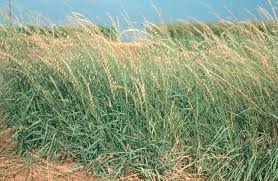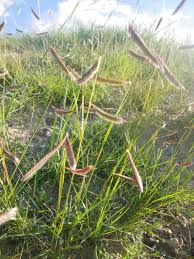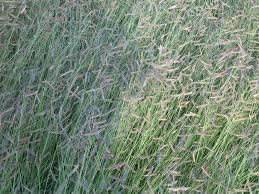Sideoats Grama Grass, also known as Bouteloua curtipendula, is a type of grass that grows in many parts of North America. This grass is special because of its unique appearance and its importance to the environment.
Sideoats Grama Grass has long, slender stems that grow up to two feet tall. The grass gets its name from the distinctive way its seeds hang on one side of the stem, like little beads on a string. These seeds are a valuable food source for birds and small mammals.
This type of grass is not just important for animals. It also plays a big role in the ecosystem. Sideoats Grama Grass helps prevent soil erosion. When its roots grow deep into the ground, they hold the soil in place, stopping it from washing away during heavy rains. This helps to keep the land healthy and fertile for other plants to grow.
Farmers and ranchers also appreciate Sideoats Grama Grass because it provides nutritious forage for grazing animals like cattle and deer. This grass can survive in tough conditions, like dry and hot climates, making it a reliable source of food for animals even when water is scarce.
In addition to its practical uses, Sideoats Grama Grass is also valued for its beauty. Its delicate seeds swaying in the wind create a picturesque scene, especially when planted in large fields or meadows. Many people enjoy the sight of these grasses dancing in the breeze.
Gardeners and land managers often use Sideoats Grama Grass for landscaping and restoration projects. Its hardiness and adaptability make it a great choice for restoring areas that have been damaged by human activity or natural events.
In addition, Sideoats Grama Grass is a remarkable plant with its unique appearance and important ecological roles. From providing food for animals to preventing soil erosion, this grass contributes to the health of various ecosystems. Its simple yet elegant beauty adds to its appeal, making it a favorite among both nature enthusiasts and those working to restore the land.
Read Also: How and When to Fertilize a Pineapple Farm
Growing and Care Guide of Sideoats Grama Grass

Here’s a simple guide on growing and caring for Sideoats Grama Grass:
Growing Sideoats Grama Grass
1. Choose the Right Location: Sideoats Grama Grass thrives in full sun, so select a spot in your garden that receives at least 6 hours of direct sunlight each day.
2. Prepare the Soil: This grass prefers well-draining soil. If your soil is heavy or clayey, consider adding compost to improve its drainage.
3. Planting Seeds: Sow the seeds in the spring or early summer, when the soil has warmed up. You can simply scatter the seeds on the soil surface or plant them in rows, about 1/4 to 1/2 inch deep.
4. Spacing: Leave about 12 to 18 inches of space between each plant to allow them to grow and spread.
5. Watering: Keep the soil consistently moist until the grass is established. Once established, Sideoats Grama Grass is quite drought-tolerant and can thrive with less frequent watering.
Caring for Sideoats Grama Grass
1. Pruning: In late winter or early spring, you can give the grass a light trim to remove dead or damaged growth. However, avoid cutting too much, as Sideoats Grama Grass adds to its appeal with its unique seed heads.
2. Fertilizing: This grass doesn’t require much fertilization. A light application of a balanced fertilizer in the spring can help promote healthy growth.
3. Weeding: Keep the area around the grass clear of weeds, as they can compete for nutrients and water.
4. Mulching: A layer of mulch around the base of the plants can help retain moisture and control weed growth.
5. Pest and Disease Control: Sideoats Grama Grass is generally resistant to pests and diseases. However, keeping the plants healthy through proper care can prevent any potential issues.
6. Division: If your grass becomes overcrowded, you can divide the clumps every few years in the early spring. This helps maintain the health of the plants and promote new growth.
7. Seed Collection: If you want to propagate more Sideoats Grama Grass, you can collect the seeds in late summer or early fall. Allow the seeds to dry before storing them in a cool, dry place.
Remember, Sideoats Grama Grass is adapted to native environments and can thrive with minimal intervention. Its natural beauty and resilience make it a wonderful addition to gardens, landscapes, and restoration projects. By following these simple steps, you can successfully grow and care for this unique and beneficial grass species.
Importance of Sideoats Grama Grass

The importance of Sideoats Grama Grass extends beyond its physical attributes, as it plays a significant role in both ecological and human contexts:
1. Ecosystem Stability: Sideoats Grama Grass contributes to ecosystem stability by preventing soil erosion. Its deep and extensive root system anchors the soil, reducing the risk of soil loss during heavy rainfall or wind events. This helps maintain the health of the soil, supports other plant growth, and protects water quality by preventing sediment runoff.
2. Biodiversity Support: The seeds of Sideoats Grama Grass serve as a valuable food source for various wildlife species. Birds, such as sparrows and quails, are especially fond of the seeds. By providing essential nutrition, the grass supports diverse bird populations and small mammals, enhancing local biodiversity.
3. Drought Resistance: Sideoats Grama Grass is known for its drought tolerance, making it an excellent choice for regions prone to water scarcity. Its ability to survive and thrive under dry conditions can contribute to sustainable landscaping and reduce water consumption in areas where water resources are limited.
4. Soil Health and Carbon Sequestration: As Sideoats Grama Grass grows and matures, its root system helps improve soil structure, allowing for better water infiltration and nutrient circulation. Additionally, the grass contributes to carbon sequestration by storing carbon in its roots and the surrounding soil, thereby mitigating the effects of climate change.
5. Habitat Restoration: Sideoats Grama Grass is often used in habitat restoration projects to rehabilitate disturbed or degraded areas. Its hardy nature and ability to establish in challenging environments aid in the recovery of ecosystems affected by human activities, such as construction or mining.
6. Aesthetic and Recreational Value: Beyond its ecological benefits, Sideoats Grama Grass adds aesthetic value to landscapes. Its elegant appearance, especially when the seeds sway in the breeze, enhances the visual appeal of gardens, meadows, and open spaces. This visual charm contributes to the enjoyment of nature and outdoor activities.
7. Livestock Forage: Sideoats Grama Grass provides a nutritious forage option for livestock, such as cattle and deer. Its availability as a natural food source helps support grazing animals, particularly in arid and semi-arid regions where alternative forage options may be limited.
However, Sideoats Grama Grass is a vital component of ecosystems due to its role in preventing erosion, supporting wildlife, conserving water, and contributing to soil health. Its resilience, aesthetic appeal, and diverse uses make it a valuable asset in ecological restoration, landscaping, and sustainable land management efforts.
Read Also: How to Cultivate Grafted Wambugu Apples
Blue Grama Grass

Blue Grama Grass, also known as Bouteloua gracilis, is a special kind of grass that grows in North America. This grass has some unique features that make it important for the environment and for people.
Blue Grama Grass looks different from other grasses. It grows in small groups, and its seeds have a funny shape that looks like curved eyelashes. These seeds are important because they give food to birds and small animals.
One of the great things about Blue Grama Grass is that it helps keep the ground steady. It has long roots that go deep into the soil. This helps stop the soil from moving when there’s rain or wind. It’s like a natural protector for the land.
This grass is also smart when it comes to saving water. It can live in places where there isn’t a lot of water. This is good for places that don’t get much rain. By using less water, Blue Grama Grass helps save this important resource.
People like Blue Grama Grass for many reasons. It’s good for places where people play, like parks and sports fields. Even if many people walk on it, it stays strong. This makes it perfect for enjoying outdoor activities.
Long ago, Native American tribes found a use for Blue Grama Grass. They fed it to their horses and even used it for making things. This grass has a history that connects with people and the land.
When the ground gets messed up, Blue Grama Grass can help fix it. People plant it to help the land recover. This shows how important it is for taking care of nature.
To sum up, Blue Grama Grass is a special grass that grows in North America. It’s important because it feeds animals, holds the soil together, and saves water. People like it for playing outside, and it has a history with Native Americans. When the land needs help, Blue Grama Grass is there to make things better.
Read Also: How To Generate Money From Medical Wastes
